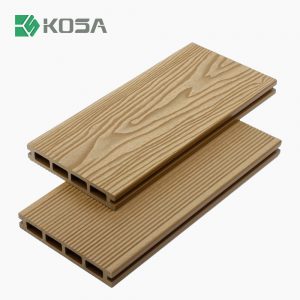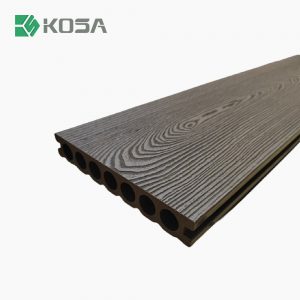As consumers increasingly prioritize quality in outdoor living, 3D composite decking—combining aesthetics, durability, and sustainability—has emerged as a top choice for patios, balconies, and garden renovations. This article explores the benefits, market trends, and buying guide for this revolutionary material, showcasing how it transforms outdoor areas.

1. What is 3D Composite Decking?
3D composite decking is an advanced outdoor flooring material made from recycled wood fibers, plastic polymers (HDPE/PP), and eco-friendly adhesives, processed under high temperature and pressure. Its surface features 3D-printed textures that mimic natural wood grains while offering enhanced slip resistance, UV protection, and longevity, outperforming traditional wood and conventional composites.
Wood Fibers: Sourced from recycled timber or bamboo, reducing resource waste.
HDPE/PP Plastics: Utilize post-consumer plastics (e.g., packaging waste) to minimize environmental impact.
Nano Coating: Boosts waterproofing and anti-mold properties for extended durability.
2. 6 Core Advantages of 3D Composite Decking
-
Ultra-Realistic Aesthetics
3D-printed surfaces replicate the natural textures of oak, teak, and other woods, available in multiple colors to suit modern design preferences.
-
Exceptional Durability, Low Maintenance
Resistant to UV rays, moisture, and mold, it withstands harsh weather for 25–30 years. Eliminates the need for staining, sealing, or seasonal upkeep required by traditional wood.
-
Eco-Friendly & Sustainable
Contains 60%–95% recycled materials, reducing deforestation and plastic pollution. Complies with LEED, FSC, and other global sustainability certifications.
-
Slip-Resistant & Versatile
Textured surfaces improve slip resistance by 50% in wet conditions, ideal for poolsides, decks, and high-humidity zones.
-
Easy Installation
Click-lock systems enable DIY installation without specialized tools, cutting labor costs.
-
Cost-Effective Long-Term
Higher initial cost than wood is offset by near-zero maintenance, delivering 40%+ lifetime savings.
3. Market Trends & Consumer Demand
According to “Grand View Research”, the global composite decking market is projected to exceed $12 billion by 2028, growing at a 9.2% CAGR, with the Asia-Pacific region leading demand.
Outdoor Living Boom: Post-pandemic surge in backyard and patio upgrades.
Green Policies: Governments restricting raw timber use and promoting recycled materials.
Customization: Rising demand for personalized colors and patterns to match contemporary architecture.
4. How to Choose High-Quality 3D Composite Decking?
Certification: Choose suppliers who provide product quality certification or testing reports
Density and strength: Choose high-density boards (≥ 1.2 g/cm ³) to achieve excellent load-bearing capacity.
Anti slip performance: Choose products that meet the R10+rating for use in humid areas.
Warranty: Suppliers who provide a warranty period of more than 15 years.
After sales support: Choose a supplier that provides installation guides and after-sales service.
5. Applications of 3D Composite Decking
Residential: Villa gardens, rooftop terraces, balcony railings
Commercial: Hotel outdoor dining areas, pool decks, landscaped walkways
Public Infrastructure: Park boardwalks, marina platforms, urban plazas
6. Why Choose Us?
As a leading 3D composite decking supplier, we provide:
- 100% Recycled Materials compliant with EU REACH standards
- 20-Year Warranty with dedicated customer support
- Free Samples & Custom Design Solutions
Contact us today for a quote and transform your outdoor space!
Keywords
3D composite decking, eco-friendly outdoor flooring, composite decking supplier





